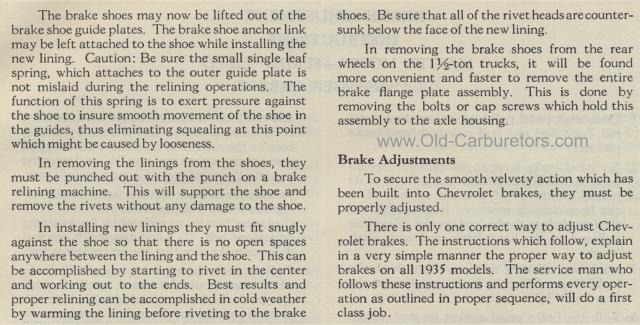Skip to: site menu | section menu | main content
The brake shoes may now be lifted out of the brake shoe guide plates. The brake shoe anchor link may be left attached to the shoe while installing the new lining. Caution: Be sure the small single leaf spring, which attaches to the outer guide plate is not mislaid during the relining operations. The function of this spring is to exert pressure against the shoe to insure smooth movement of the shoe in the guides, thus eliminating squealing at this point which might be caused by looseness.
In removing the linings from the shoes, they must be punched out with the punch on a brake relining machine. This will support the shoe and remove the rivets without any damage to the shoe.
In installing new
linings they must fit snugly against the shoe
so that there is no open spaces anywhere between the lining and
the shoe. This can be accomplished by starting to rivet in the
center and working out to the ends. Best results and proper relining
can be accomplished in cold weather by warming the lining before
riveting to the brakeshoes. Be sure that all of the rivet heads
are counter-sunk below the face of the new lining.
In removing the brake shoes from the rear wheels on the 1 1/2
ton trucks, it will be found more convenient and faster to
remove the entire brake flange plate assembly. This is done
by removing the bolts or cap screws which hold this assembly
to the axle housing.
Brake Adjustments
To secure the smooth velvety action which has been built into
Chevrolet brakes, they must be properly adjusted.
There is only one correct way to adjust Chevrolet brakes. The
instructions which follow, explain in a very simple manner the
proper way to adjust brakes on all 1935 models. The service man
who follows these instructions and performs every operation as
outlined in proper sequence, will do a first class job.
